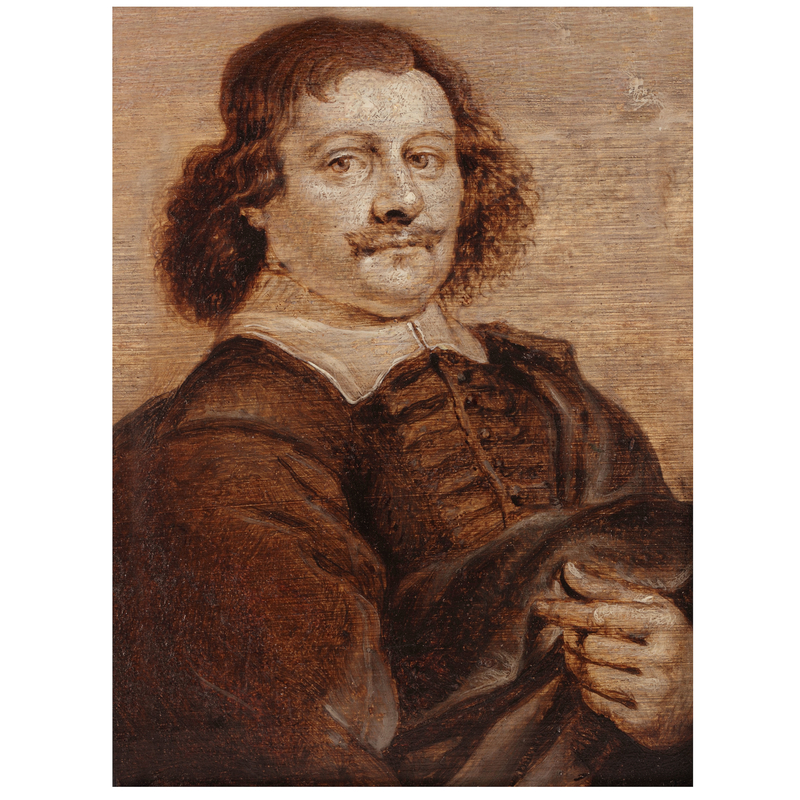Abraham Willaerts, 'Portrait of Jan Both'
Global shipping available
- Origin
- Utrecht
- Period
- C. 1628-1669
- Material
- Oil on panel, en grisaille
- Height
- 13.5 cm
- Width
- 10.5 cm
- Literature
M. Van Groesen, ‘Abraham Willaerts: Marine painter of Dutch Brazil and the Atlantic world’, Oud Holland - Journal for Art of the Low Countries, 132(2-3), pp. 65-78.
Questions about this object?
Please use one of the contact options below:
Description
This portrait (grisaille) of Jan Both was painted by the Utrecht painter Abraham Willaerts (c. 1603 - 1669). The depicted Jan Both (1618 - 1652) was a painter, draughtsman and printmaker. He mainly painted landscapes and is counted among the second generation of Italianate painters. He is turned to the left and depicted from the waist up, with long hair, a moustache, a goatee, a flat collar and a cloak. The portrait is executed in grisaille, a painting technique using only a monochrome colour palette, often in grey or brown. This technique was often used in preparatory studies for engravings since the light and dark in the grisaille is very clear, guiding the engraver to determine where shadows and lines should be placed.
The portrait of Willaerts served as an example for the portrait of Jan Both by Coenraet Waumans (1616 - after 1675). This engraving, depicting Both mirrored in comparison with the grisaille, is included in ‘Het Gulden Cabinet vande edele vrye Schilder-Const’. This work, printed in Antwerp in 1662 and compiled by Cornelis de Bie, provides an overview of the most renowned painters from the Southern Netherlands. Beneath the engraving by Coenraet Waumans, it says ‘Abr. Willers pinxit, C. Waumans sculpsit, I. Meyssens excudit’: painted by Abraham Willaerts, engraved by Coenraet Waumans, printed by Joannes Meyssens. Abraham Willaerts, like his father Adam Willaerts, is mainly known for his marine paintings. He also painted (group)portraits, genre paintings, history paintings and landscapes. His two brothers, Cornelis and Isaac, were also well-known painters. Willaerts was born in Utrecht, he was trained by his father, and joined the Utrecht Guild of Saint Luke in 1624. He worked in the studio of the Utrecht Caravaggist Jan van Bijlert and left for Paris in 1628, where he worked in the studio of the French painter Simon Vouet. After seven years he returned to Utrecht. From 1638 to 1644, Willaerts was employed by the Governor of Dutch Brazil, Johan Maurits van Nassau-Siegen, and stayed at court in Recife and was later transferred to Angola. Together with Frans Post and Albert Eckhout, among others, he captured the landscape, inhabitants, flora and fauna on canvas. After his time in Angola, he returned to the Netherlands and stayed in Amersfoort with the architect and painter Jacob van Campen. In 1659-1660 he visited Rome and was a member of the Bentvueghels, a group of Dutch and Flemish painters who worked in Rome. There he was nicknamed ‘the Indian’, a reference to his time in Recife and Angola.
Engraving of Jan Both by Coenraet Waumans, after this Portrait by Willaerts, Rijksmuseum Amsterdam, ‘Portrait of the painter Jan Both’, inv. RP-P-1940-931
Centraal Museum Utrecht, ‘Portrait of Jan Both’, inv. 13975
Database of the RKD (Netherlands Institute for Art History)







